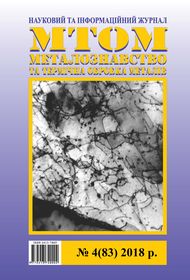Method of forecast of mechanical properties of Ст3пс steel
DOI:
https://doi.org/10.30838/J.PMHTM.2413.261218.10.559Keywords:
mechanical properties, steel, perlite, ferrite, fractal dimension, forecasting techniqueAbstract
Abstract. Problem statement. The prediction of mechanical properties of metals is mainly based on the analysis of statistical data and the results of direct experiments. When comparing these results, in some cases there are discrepancies between the results of the prediction of mechanical properties based on the quantitative indicators of the structure and the data of field tests. One of the reasons for the divergence of results may be the incompleteness of formal axiomatics in describing the real elements of a structure. Therefore, the paper proposes to use the fractal approach based on the determination of fractal dimensions of the constituents of the structure for the prediction of the mechanical properties of the metal, such as Ст3псsteel. Materials and methodology. Using the methods of regression analysis and fractal theory, we obtained a mathematical model for the prediction of the quality criteria for structural low-alloy steel Ст3псdepending on the influence of the parameters of the structure and elements of the chemical composition. Research results.The influence of the chemical composition and fractal dimension of the ferrite-pearlite structure on the mechanical properties of the steel was analyzed: tensile strength, yield strength, relative narrowing and elongation, hardness. The adequacy of the obtained results is confirmed by the Kochren and Fisher criteria. By studying the coefficients of the obtained dependences, a histogram describing the effect of the fractal dimension of the metal on the mechanical properties was obtained. As a result of experiments, it was found that the fractal dimension of perlite grains varies in the range of 1,662…1,790, and the fractal dimension of ferrite grains зер in the range of 1,955…1,978 with a change in the amount of carbon from 0,14 to 0,22 %. The highest degree of correlation among those considered is established between the fractal dimension of perlite and the indices of strength and hardness of steel 3, and the highest correlation of plasticity indices is set to the fractal dimension of ferrite. The results obtained indicate the possibility of applying fractal geometry to the prediction of the mechanical properties of low carbon low alloy structural steels. Conclusions. The technique of forecasting the mechanical properties of Ст3пс steel is presented based on the analysis of the influence of the chemical composition and fractal characteristics of the ferrite-perlite structure. It was found that when forecasting the strength and hardness characteristics of steel based on the fractal dimension of perlite, a correlation was observed within 0,50...0,59; and in the prediction of plastic properties, the correlation of 0,64...0,86 is fixed for the fractal dimension of ferrite.
References
Downloads
Published
Issue
Section
License
Authors that are published in this journal agree to follow the conditions:
Authors reserve the right to the authorship of his work and cede the right to the journal of first publication of this work on conditions of the license under the Creative Commons Attribution License, which allows others to distribute it freely with the obligatory reference to the author of the original work and the first publication of the work in this journal.

